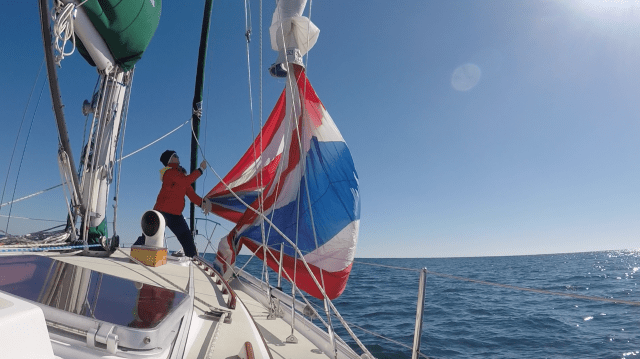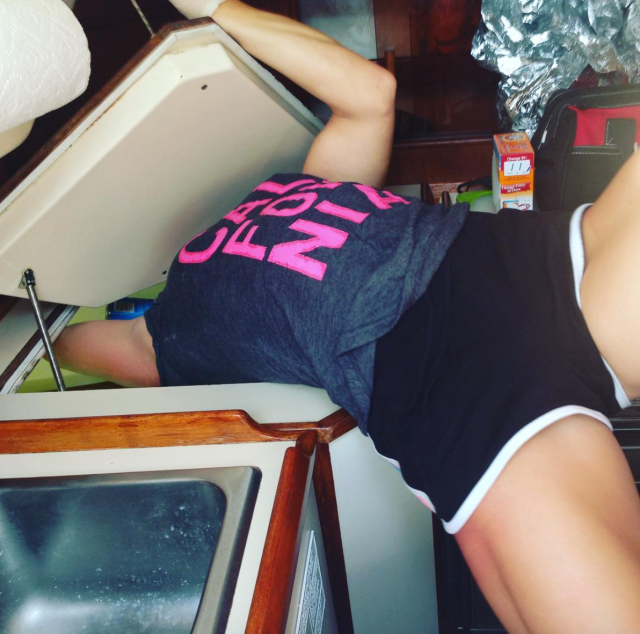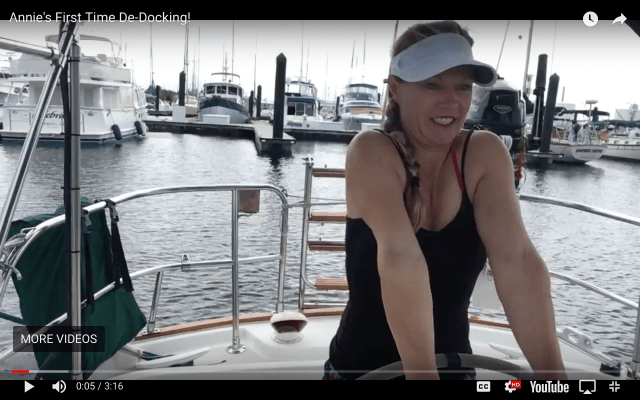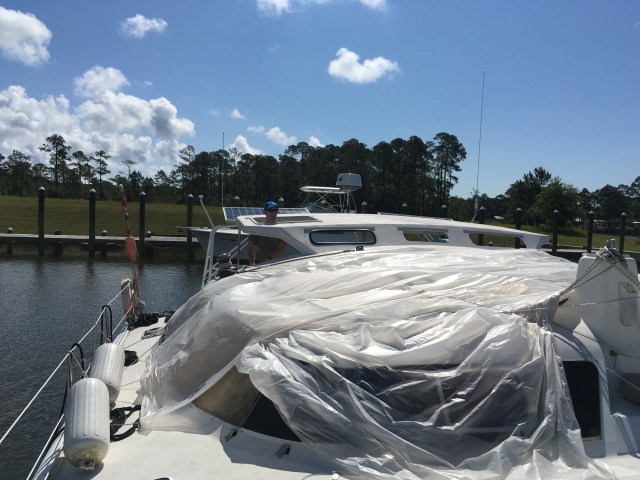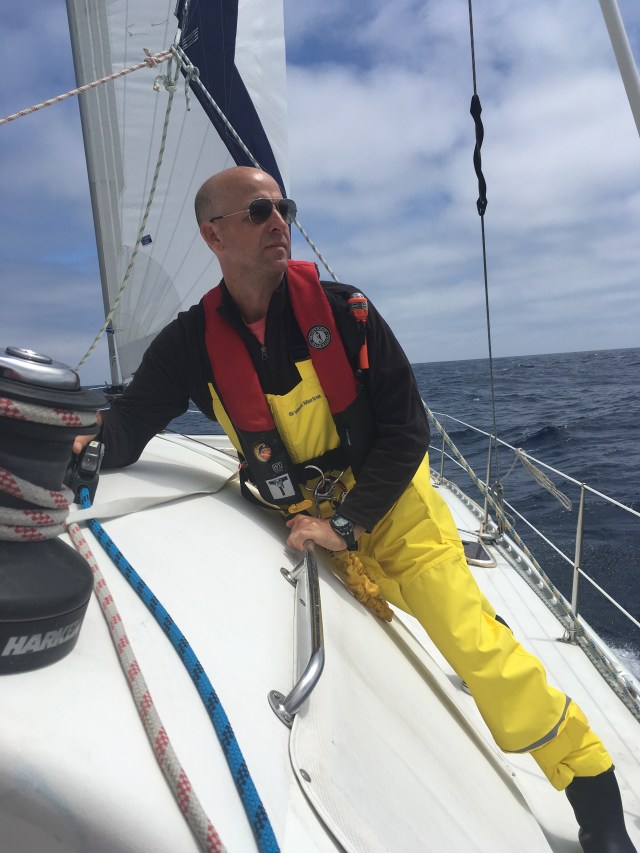There she is, hot off the press!

Man … I look a little TOO excited! But, it is exciting! Another article penned by Yours Truly, Author Annie, in SAIL Magazine, this time their Multihull Sailor edition, covering our Atlantic-crossing in 2016 on the esteemed Captain Yannick’s 46′ Freydis. I had a lot of fun with this one from start (catchy title, no? ; ) to finish, tying together a memorable moment from each of our thirty days at sea across the Atlantic Ocean. I have included the complete text from the article below so you can read at your leisure, but definitely pick up a copy when you get a chance and see what a great job the folks at SAIL Magazine did with the photos and eight-page layout.




Phillip and I also had a great time making and sending Captain Yannick a fun video letting him know about the article (it was a total surprise) and how it appears he’s right up there with the Vagabonds now. Mr. Big Time!
There she goes, crossing the Atlantic Ocean herself, off to Nice, France to find her way into Yannick’s hands. Go, little magazine. Go! Let us know when she arrives Yannick!


Without further adieu … I give you:
FIRST TIME WITH A FRENCHMAN:
A Virgin Crew Sails a Catamaran from Florida to France
Dolphins and diesel fumes. A blood orange moon rising on starboard as the muffler melts on port. A taut, glowing veil before a sun that will shine down later on its wet, shredded remains. We were thirty days at sea. A virgin ocean-crossing crew aboard a French-built multi-hulled rocket, bashing our way non-stop from Florida to France. That was the plan anyway, before the tide came in. The actual unscripted voyage, however, with all of its detours and unexpected deviations, proved infinitely more memorable than our foolish man-made scheme as daily it was feats and failures and one of the most exciting, exasperating experiences of our lives.
In the Days Before One: Fate has twisted plans for our French Captain. With both retirement as a fighter pilot in the French Navy and his family’s next chapter as live-aboard cruisers on the horizon, Yannick has one solitary goal in mind: sail his 2005 46’ Soubise Freydis single-handed, non-stop from Pensacola, Florida home to Roscoff, France. Fate, laughing, devastates his boat with a lightning strike that suffers Yannick six costly months at the yard but also an impressive re-fit and a loyal, motley bunch to serve as his Atlantic-crossing crew.
Crew emerges first in the form of Johnny, a weathered sailor and diesel engine mechanic who helps Yannick repair his engines and who—at 71, still surprisingly healthy and with bucket in hand—seeks to scratch “cross the ocean” off his list. My boyfriend, Phillip, and I—slugging away on a devastating re-fit of our own Niagara 35 at the yard—catch wind the Frenchman on the freaky-looking cat is taking on crew and shamelessly ask for passage. Having crossed only in cavernous carrier ships to remote, scorned places in his youth as a U.S. Marine, Phillip is chasing his lifelong dream to cross the pond in a small boat. A tomboy turned lawyer turned “this sucks, I quit” vagabond so I can seize the very type of opportunity a trans-at affords, I sign on for fist-clenching adventure and blue water experience. Two weeks from cast-off, the newly-formed crew scrambles to replace blown windows, step the mast, test new sails and pack the cat with thirty days’ worth of food, safety gear and supplies in the sweltering Florida May heat.
Day One: Heat pours out of the starboard engine locker as Yannick lifts the lid two hours out of the Pensacola Pass, with the high temp alarm still ringing in the crew’s ears. Boiling the extracted thermostat reveals impaired coolant flow and installation of a new one affords us a slightly high, but steady temp on the Lombardini albeit with a “lot of piss,” I note. The Captain finds it comforting enough to keep motoring across the glassy Gulf and amusing that the first language I start to pick up on is Diesel, not French.
Day Two: “It’s French for ‘Cheers,’” Yannick tells us as the crew “Santés” over an immaculate steak dinner in the cockpit. The motoring, while monotonous, affords us beautiful satin sunsets in the cockpit and leisurely time for quid pro quo French-English lessons. “Well how should I say it?” Yannick asks when I snort at his post-dinner inquiry of “How are you going to clean your dirty body?” Chuckling, I reply, “Would you like to take a shower?”
Day Three: Showers of glitter trail behind them as they zip and glide through the dark waters below the bow. Yannick and I forge a lifelong memory during a midnight shift change when we are mesmerized by a pod of dolphins slicing through phosphorescence. Forty-six feet away from the chugging engine on starboard, their breathy puffs and water lapping on the hull are the only things we can hear.
Day Four: “Did you hear an oil alarm?” Johnny asks, raising his head and greasy hands out of the starboard engine locker, a silk sheet of saltwater behind him, trying to figure out why, at 5:06 a.m., the starboard engine shut down on its own. Replacing a clogged fuel filter proves an easy engine fix. Making drinkable water with a faulty water-maker proves not and starts the slow parade of minor equipment failures and boiling of the Captain’s blood.
Day Five: Blood rains down from the fighting tuna on his hook as Phillip thunders “Fish on!” to the crew. Soon, boat sushi is bouncing in our bellies during a swift, sweaty two-hour stop in Key West for fuel, ice, water, “And a not so crappy can opener!” Yannick shouts, orchestrating our pillage from the boat as the crew shoots into the town like darts.
Day Six: Rain darts into Yannick’s eyes at the mast while he directs the crew’s first attempt reefing as a squall off the tip of Florida brings winds over thirty on the port beam. A merely intense but brief storm proves fortuitous as the crew learns their many mere discussions about safe practices did not serve them near as well as drills would have. The afternoon is spent doing reefing drills where the Captain has made separate reefing instructions for each crew member and taped them up at his/her designated post.
Day Seven: “Post A connects to Post B,” Yannick reads from yet another manual. I watch in half-admiration, half-exhaustion as the Captain flutters from one boat project to the next, cleaning out the elbow of the starboard engine exhaust, tapping new holes in the water pump, even sawing a chunk out of our only cutting board to make a mount for the windex that allows it to account for the fancy rotating mast on the Freydis. “That’s fine,” our head chef, Phillip, grunts from the galley. “If you use it all, I’ll just cut on the counters.”
Day Eight: Cans jump on the counters. Teeth jar in mouths. The bashing of the water on the hulls of the catamaran is like a nervous system message so strong it bypasses your brain. Muscles flinch without instruction. The crew grows accustomed but never comfortable with it. When two hundred nautical miles are slaughtered in a day, we know: with the bashing comes bumpy but beneficial speed.
Day Nine: “It is used, primarily, for speed,” Yannick says, trying simultaneously to learn and teach the crew the purpose of his rotating mast, one with so much windage it can be trimmed like a sail. Strictly monohull sailors, the crew stares at him dumbly, not nearly as intrigued by the ability to use the mast as a fourth reef as the initial inquiry that started this free physics lesson: With a rotating mast, what happens if you overtighten the shrouds?
Day Ten: The shrouds continue their murderous shudder with each crash of the boat. As non-catamaran sailors, the crew knows not how tight the shrouds on a Freydis should be but, as mere sailors, they know they should not be so loose as to vibrate and clang to their death with each romp of the boat through the Atlantic. The Captain sends satellite messages to professionals, checks hourly the chain plate on the port side and tears through texts on rig tuning.
Day Eleven: “Tuning must be done very slowly,” Johnny and I chuckle to ourselves, cotter pins in our teeth, wrenches in trembling hands, as we tighten the shuddering shrouds on each side the following morning and wonder how anyone could possibly do this quickly. Coupling this “slowly” advice from a rigger back home with a turnbuckle thread measurement from the previous owner, Yannick supervises the rig tuning and we slowly ease the shuddering of the rig underway.
Day Twelve: While underway on a cat, it is a myth you do not have to stow anything. Bowls slosh off counters. Wine glasses topple (but are quickly refilled) as the crew members “Cheers!” a record 243 nautical-mile day and peak boat speed of 19.5 knots. Steady winds of twenty-three and eight to ten-foot rolling seas entrance as the catamaran climbs and skids down each magnificent wave.
Day Thirteen: “Magnificent,” Yannick sneers as he eyes the melted end of the muffler Johnny has extracted off the port engine at dawn. Phillip and I now know we were wrong in thinking the eased winds and smooth motoring the night before had been a gift as we now cough up plastic melted fumes while clambering out from our port berth. Undeterred, Yannick earns his “MacGyver certificate” for the trip by reassembling the melted exit point of the muffler with the PVC tiller extender arm for his outboard, a blow torch and some hose clamps.
Day Fourteen: Hands clamp and tug the head of the spinnaker as she billows ethereal and enormous in the water behind the starboard transom. Her halyard cinched only in the winch but not clutched at the mast allows the sinister waters of the Atlantic to suck her down between the hulls and drag her all the way back to the stern. Yannick, in a sacrificial attempt to salvage both the sail and the rudder on starboard, emerges blood-spackled, dripping on its remains splayed out on the trampoline, wet, twinkling and tattered.
Day Fifteen: “Tattered glittery skirts,” I hear Yannick telling Phillip as he hunts for a hard drive. Mourning the loss of our spinnaker, Yannick claims, will be eased by a video he and the other wearisome pilots used to watch during long hours on the carrier ship. It is a four-hour rendering of the glittered, scantily-clad, cosmetically-enhanced women who populate the neon-lit night clubs of Ibiza, and he is right. We find ourselves immensely comforted by thumping pink panties.
Day Sixteen: “They’re my Paris panties,” I explain as Yannick eyes a pair of rather fifth-grade looking underwear with little Eiffel Towers and “Bonjour’s” on the lifelines. “I bought them special for the trip,” I say with a smile as Laundry Day proves special bonding time for the crew and reminds us all how truly few blue-water days we have left.
Day Seventeen: Left, only left. It freezes the wheel only when Yannick turns left. The ten-year old electronic auto-pilot on the cat starts to show its first signs of wear when it refuses to disengage when de-powered and allows steering only to the right in what the Captain dubs “ratchet-fashion.”
Day Eighteen: “Hand me a ratchet.” Yannick’s requests come muffled from the starboard engine locker as the auto-pilot’s housing refuses him any attempt for disassembly or repair underway. Auto-Turn-Notto will die. Soon. All we can do is watch and listen as each mechanical movement of the wheel is followed by a grind and squeal.
Day Nineteen: “Whee!” I can’t help it. Gleeful squeals leak out of me at the top of each wave. The boat moves underneath me like a stallion galloping at speeds equal to the 22-knot winds that hold during my entire night shift. But when a wave kicks the the stern out and shoves us almost ninety degrees off our heading, the thought that it might soon fall on me to right us, I stop squealing and decide to get my bearings.
Day Twenty: Bearings and bolt threads that were once intact and operating in the cavity of the auto-pilot now pour out into a pile of metal dust on the salon table. “R.I.P. Auto” reads the log book as I head up to hold my first night shift hand-steering. “Dress warm. Wear gloves,” Phillip warns.
Day Twenty-One: Warning him we “should not do it” would have been better, but the crew knee-jerks initially and simply tells the Captain we “can do it” as he struggles to decide whether to hand-steer the remaining eight or nine days to France versus stopping in two days when we reach the Azores to repair the auto-pilot. A stern discussion between the fighter pilot and the Marine results in a wise decision to stop our non-stop voyage mid-Atlantic.
Day Twenty-Two: “Mid-Atlantic Yacht Services,” she answers over the sat phone as the crew books a slip at Horta Marina and schedules auto-pilot repairs with MAYS fifteen hours out from the Azores. Morale soars as we see whales and our first sighting of land in sixteen days and immediately tanks when bad injectors on the starboard engine cause it to shut down an hour out from port.
Day Twenty-Three: I’m on port with the big “boat-saver” fender as we shove off from the hundreds of colorful, weathered boat insignia on the Horta dock. After nine incredible days downing beers at Peter Café Sport, exploring volcanos, and indulging on impossibly fresh cheese and beef from the very cows chewing cud and watching you eat from the hillside, we leave the Azores under port engine alone but steer our catamaran north to France by daintily clicking buttons on a screen.
Day Twenty-Four: The screen lights our faces as the crew indulges in book after book, movie after movie, matinees, even double features in beautiful fifteen knot winds on the stern. Crossing an ocean with a functioning auto-pilot makes even devil’s work too much for our idle hands.
Day Twenty-Five: My hands are tied. Yannick has outright busted me. “Oh, it’s a time change day,” he says in a mocking high-pitched voice. “Oh, we need to conveniently jump forward an hour again during Annie’s shift again,” as he squints his evil French eyes at me. Putain! Time change occurs during Phillip’s shift that day and I take revenge by choosing My Cousin Vinny as the movie that night as it seemed, among our rather impressive 500GB hard-drive of movies, the most … American.
Day Twenty-Six: “Try not to act so American.” Yannick advises us as we approach Roscoff. “No selfies, eat slow, wait for the check, and don’t revert to Spanish when you can’t recall your French” he looks at me. “We know the difference.” Fun, lighthearted discussions about our expected arrival in two days seem to jinx us as the day ends with a rather harrowing hoist of the Captain up his seventy-two foot mast after the main sail came flying down on its own inexplicably around dusk. We suspect the topping lift, inadvertently left taut, may have chafed through the main halyard. This mystery, however, is instantly tabled when the Captain’s descent brings worse news: the rig is compromised. The troubling shuddering of the shrouds earlier in the trip has caused five of the sixteen wires on the starboard shroud to snap just below the swage at the mast. Worried a wind-filled main or worse, change to a starboard tack, could dismast us, the crew decides to remain on a port tack, flying only the genny for the remainder of the now four- to five-day trip. Yannick spends the night poring over rigging textbooks and catamaran specs.
Day Twenty-Seven: Yannick spends the morning documenting potential cracks at the base of the mast and re-tightening the spinnaker halyard we ran to a starboard cleat in case the shroud goes. I find him later standing in silence, his heavy head laid against the bulkhead in his berth. The crew tries to rally le capitaine with the cinematic masterpiece that is Hot Tub Time Machine and succeeds when we settle upon Yannick’s mantra for the trip—“I’m on my waa-ay. Home sweet home!”—blasted at decibels that could be heard from Roscoff, rounding out the movie’s final score.
Day Twenty-Eight: I score no sympathy points from the Captain in my plight as I pass him at 2:00 a.m., flashlight in hand, on my way to the port engine locker. I can’t decide whether I want to prove or disprove my mind’s wild concoction—down in the auditory carnival that is my berth—that the port engine has become submerged, fallen out and left a gaping hole in the hull of the boat. Yannick laughs when I seem vexed at the sight of a completely safe, dry engine and says, “Tonight, I’ve only slept twenty minutes.”
Day Twenty-Nine: Twenty ships surround us in the English Channel. The radar screen that has offered only an empty halo around our boat for weeks is now filled with dozens of vessels. The excitement of the night shift is bittersweet as we all know it is our last on this trip. In an amazing show of endurance and inspiration, the boat and Captain, equally tired and compromised, carry on, both fighting their way to France.
Day Thirty: Fighter pilots scream by in a heroic show of unity seeing their former comrade coming home by way of sailboat across the Atlantic Ocean. Yannick waves heartily at them from the bow, his smile so big I can see it from the stern. A small crowd cheers as the crew and boat see it, the finish line, the final feat in sight as we prepare to dock the gallant Freydis in Roscoff. Yannick’s son’s is the first voice we hear in France as his small, powerful pipes rip through the air: “Bonjour Papa!”








